Economy

Manufacturing Indicators Remain Positive through Fourth Quarter
Written by Brett Linton
January 5, 2022
Data on U.S. industrial production, capacity utilization, new orders and inventories continued to improve throughout fourth-quarter 2021, indicating a strengthening manufacturing sector. The health of the manufacturing economy has a direct bearing on the health of the steel industry. Note that some of the historical data below has been adjusted by the U.S. Census Bureau and Federal Reserve, with some revisions going back as far as the mid-2000s.
![]() The Industrial Production Index
The Industrial Production Index
The IP index is a gauge of output from factories, mines and utilities. Industrial production took a serious hit from the shutdowns of nonessential businesses and other measures mandated by the government in mid-2020 to stem the spread of the coronavirus. Figure 1 shows the three-month moving average (3MMA) of the IP index since February 2007 as the black line and the year-over-year change in orange. We use the 3MMA calculations here to smooth out some of the monthly variability. From March through June 2020, the 3MMA of the IP index declined 13%, reaching a 10-year low of 87.1. The 3MMA has recovered nearly each month since, climbing to 102.3 in November, up 5.1% over the same period last year and the highest measure since September 2019.
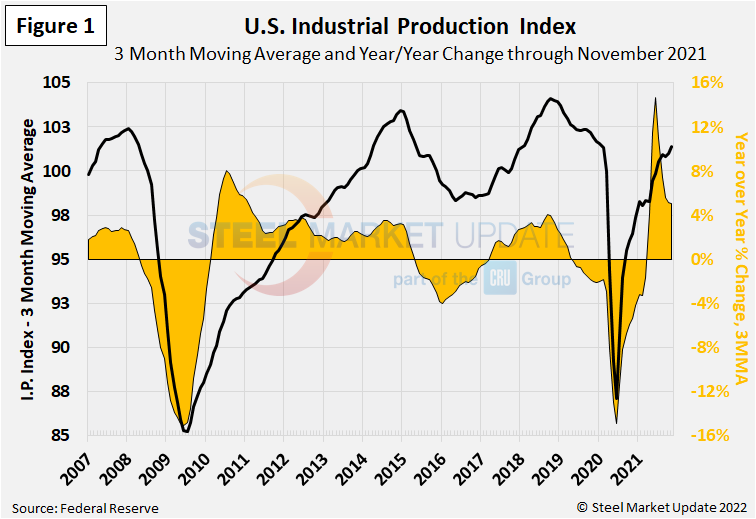
Manufacturing Capacity Utilization
Manufacturing capacity utilization through November was measured at 76.7% as a 3MMA, the 14th consecutive month above recessionary territory, and the highest 3MMA rate recorded since February 2019. The rate had hovered around 75% for most of the 2010’s, but began to decline in April 2020 and reached a low of 64% in June 2020 (Figure 2).
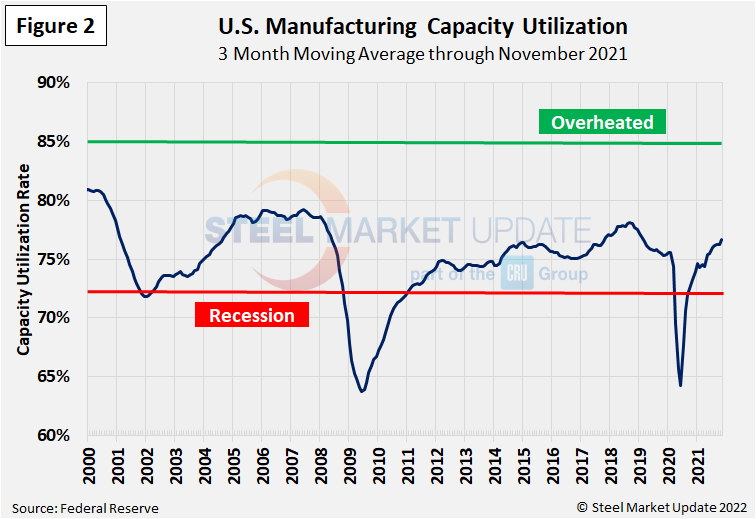
New Orders for Durable Goods
New orders for durable goods, an early indicator of consumer and business demand for U.S. manufactured goods, continues to recover from the 2020 shock and reached a new record level in November (Figure 3). New orders increased to $263.8 billion as a 3MMA through November 2021, the highest level in our history dating back to 1992. The 3MMA had dropped by 23% from February through May 2020, reaching a 10-year low of $188.4 billion.
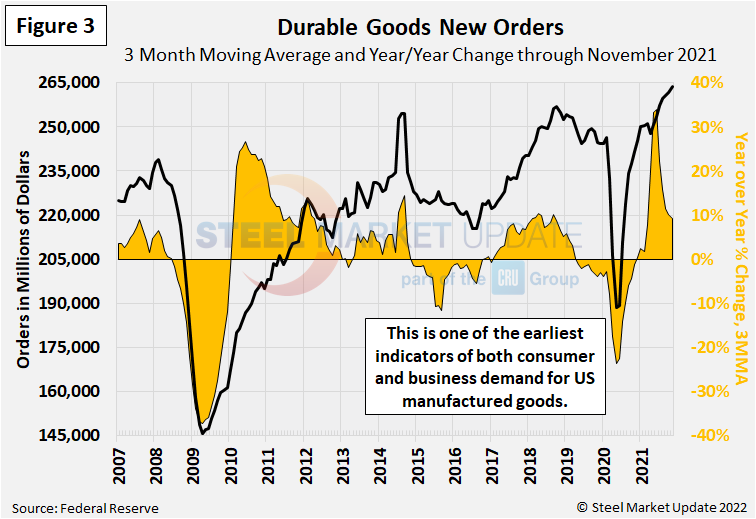
New Orders for Manufactured Products
The growth rate of new orders for manufactured products as reported by the Census Bureau was slightly negative for most of 2019, then declined sharply from March to July 2020 (Figure 4). On a 3MMA basis, factory orders have increased each month since then, reaching $518 billion in August 2021. This is up 15.4% compared to one year prior, and at the highest level seen since September 2014.
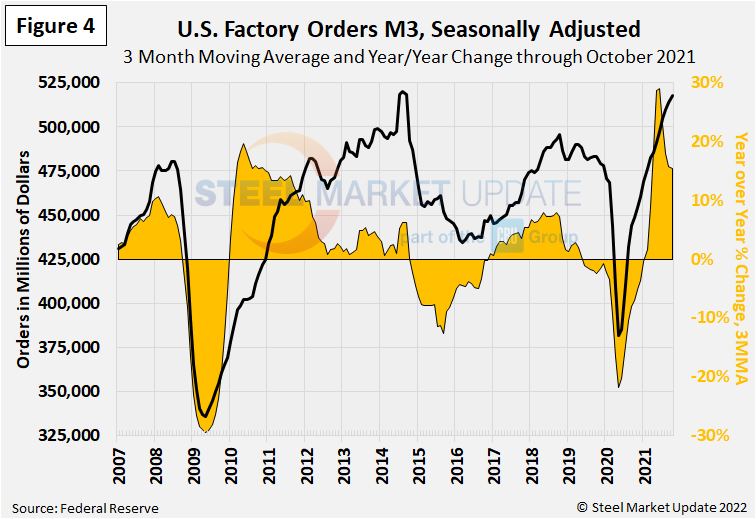
New Orders for Products Manufactured from Iron and Steel
Within the Census Bureau M3 manufacturing survey is a subsection for iron and steel products. Figure 5 shows the history of new orders for iron and steel products since 2007 as a 3MMA. The 3MMA year-over-year growth rate, which reached negative 23.4% last May, has climbed to a positive 30.4% as of October at $12.3 billion (3MMA). This is now the highest new order level seen since February 2012. Back in June 2021, the 3MMA year-over-year growth rate reached a multi-year high of 49.6%, the highest rate since July 2010.
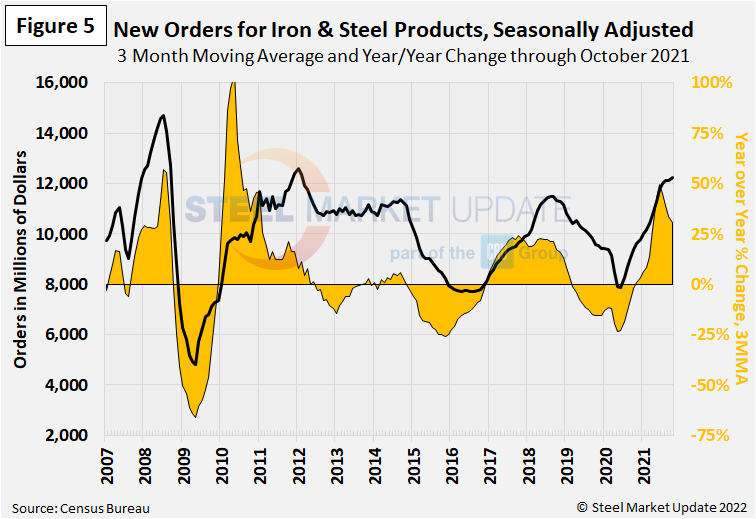
Inventories of Products Manufactured from Iron and Steel
Inventories of iron and steel products broke their multi-month decline streak in November 2020, and have risen each month since. The latest iron and steel inventory levels totaled $23.4 billion on a 3MMA basis in October, up 23.4% compared to the same period the year prior (Figure 6). This is now the highest 3MMA measure seen in our 29-year history, and the highest year-over-year change seen since November 2011.
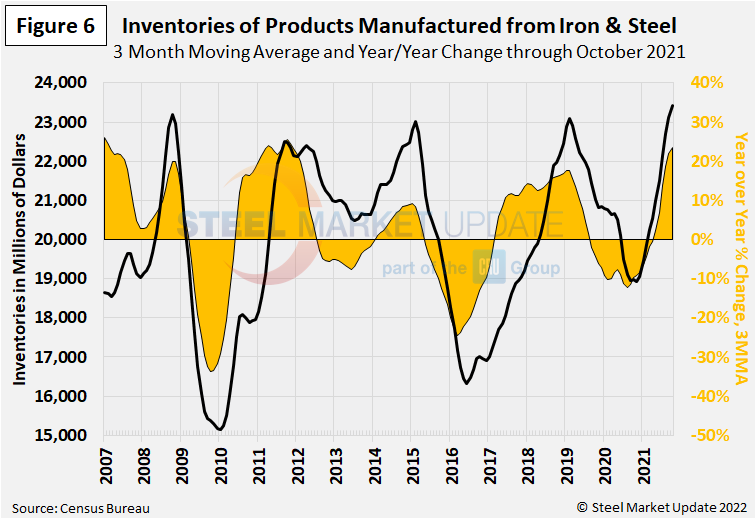
The ISM Manufacturing Index
The Institute for Supply Management® Manufacturing Index is a diffusion index. An index value above 50 indicates that the manufacturing economy is expanding. As Figure 7 shows, the index on a 3MMA basis was in contraction territory from September 2019 through July 2020. The ISM index now stands at 60.2 through December as a 3MMA, down 0.8 percentage points from the month prior but remaining strong.
“The U.S. manufacturing sector remains in a demand-driven, supply chain-constrained environment, with indications of improvements in labor resources and supplier delivery performance. Shortages of critical lowest-tier materials, high commodity prices and difficulties in transporting products continue to plague reliable consumption. Coronavirus pandemic-related global issues — worker absenteeism, short-term shutdowns due to parts shortages, employee turnover and overseas supply chain problems — continue to impact manufacturing. However, panel sentiment remains strongly optimistic, with six positive growth comments for every cautious comment, down slightly from November,” said ISM Business Survey Committee Chairman Timothy Fiore.
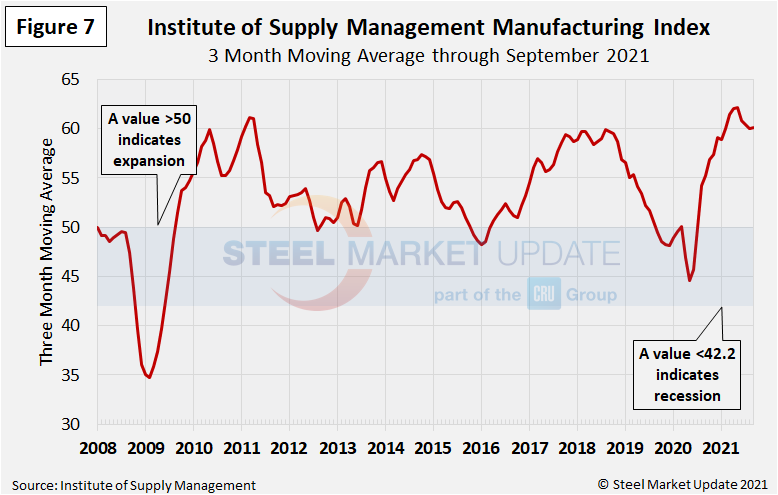
By Brett Linton, Brett@SteelMarketUpdate.com

Brett Linton
Read more from Brett LintonLatest in Economy

Chicago PMI dips 0.1 points in June
The Chicago Purchasing Managers Index (PMI) slipped 0.1 points to 40.4 points, in June.

Multi-family pullback drives housing starts to 5-year low in May
US housing starts tumbled in May to a five-year low, according to figures recently released by the US Census Bureau.

Architecture firms still struggling, ABI data shows
Architecture firms reported a modest improvement in billings through May, yet business conditions remained soft, according to the latest Architecture Billings Index (ABI) release from the American Institute of Architects (AIA) and Deltek.

Manufacturing in New York state contracts again
However, companies are growing more optimistic about the future.

ArcelorMittal plans wire-drawing closure in Hamilton, shifts production to Montreal
ArcelorMittal’s (AM) Hamilton location to be shuttered, wire production shifting to Montreal.
